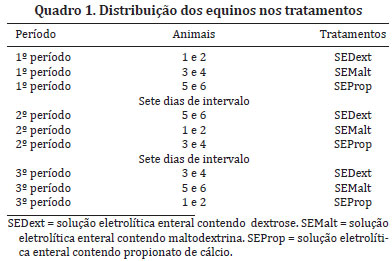We compared the effects of electrolyte solutions with different osmolarities administered through enteral route by naso-esophageal probe of small-caliber with continuos flow on the electrolytic and biochemical profile in horses. Six adult females were used in two simultaneous 6x3 Latin squares mixed model. The animals were divided into three groups and received the following treatments: HipoMalt - 5g of sodium chloride, 0.5g of potassium chloride, 0.2g of magnesium pidolate, 1g of calcium gluconate and 10g of maltodextrin diluted in 1.000mL of water (181mOsmol L-1); HipoDext - 5g of sodium chloride, 0.5g of potassium chloride, 0.2g of magnesium pidolate, 1g of calcium gluconate and 10g of dextrose diluted in 1.000mL of water (228mOsmol L-1); IsoProp - 5g of sodium chloride, 0.5g of potassium chloride, 0.2g of magnesium pidolate, 1g of calcium gluconate and 10g of calcium propionate diluted in 1.000mL of water (282mOsm L-1). The hypotonic electrolyte solutions containing dextrose (HipoDext) and maltodextrin (HipoMalt) were more effective in increase the rate glucose without causing electrolyte imbalance. Treatment with calcium propionate (IsoProp) besides increasing plasma lactate had no effect on blood glucose.
Enteral fluid therapy; hypotonic; isotonic; plasmatic volume; electrolytes



